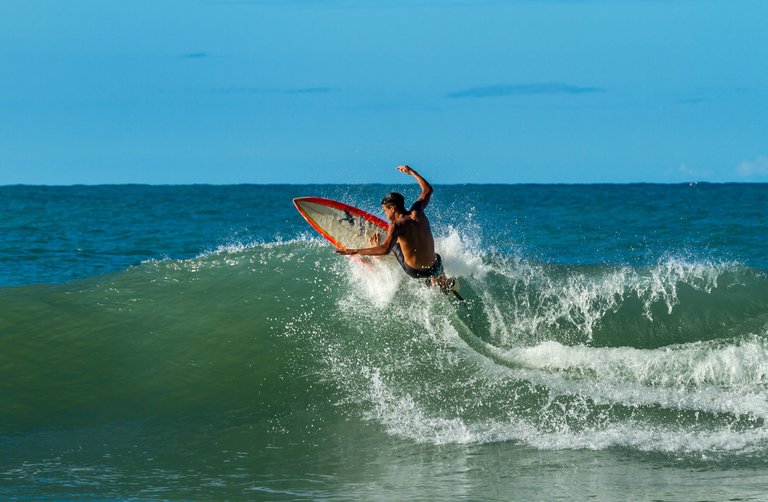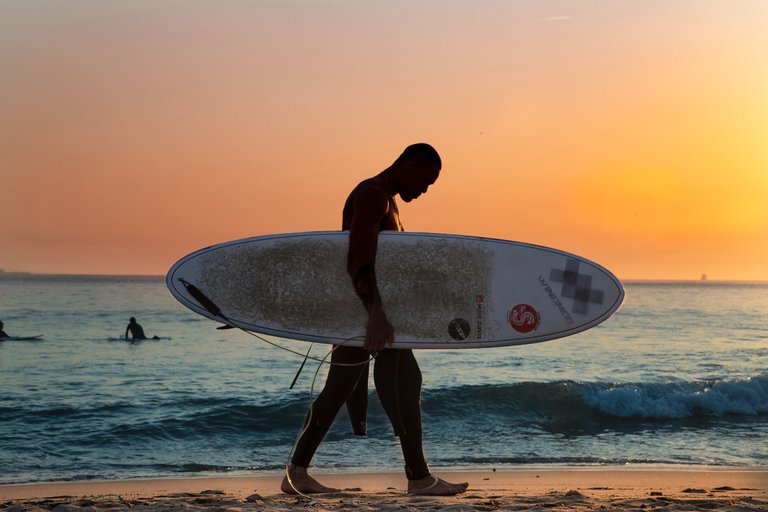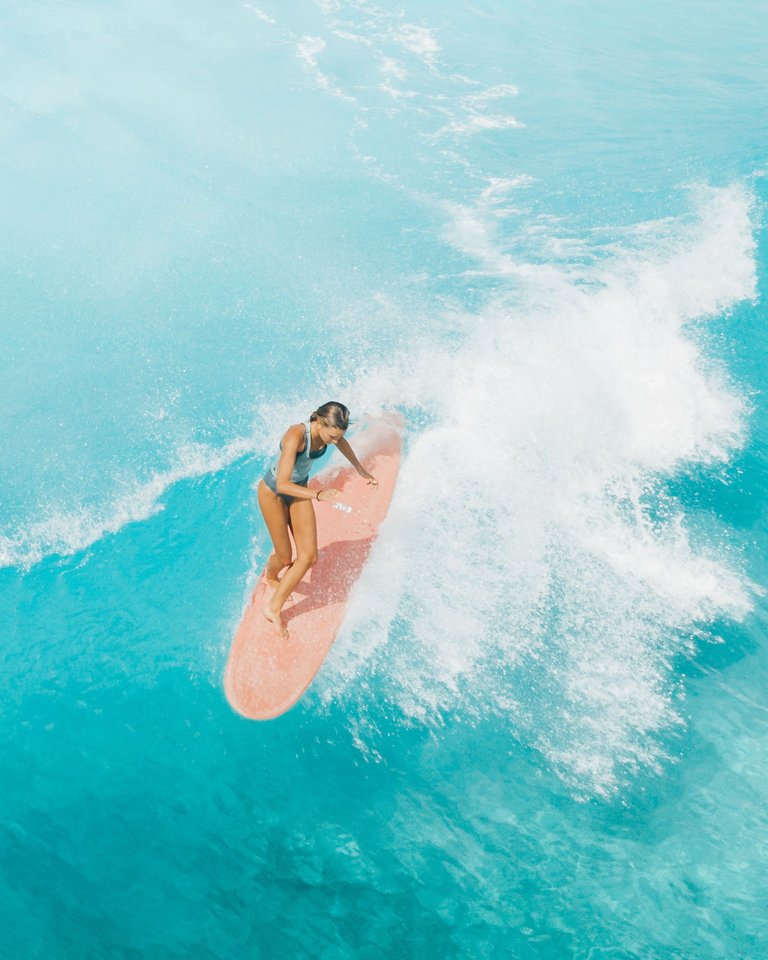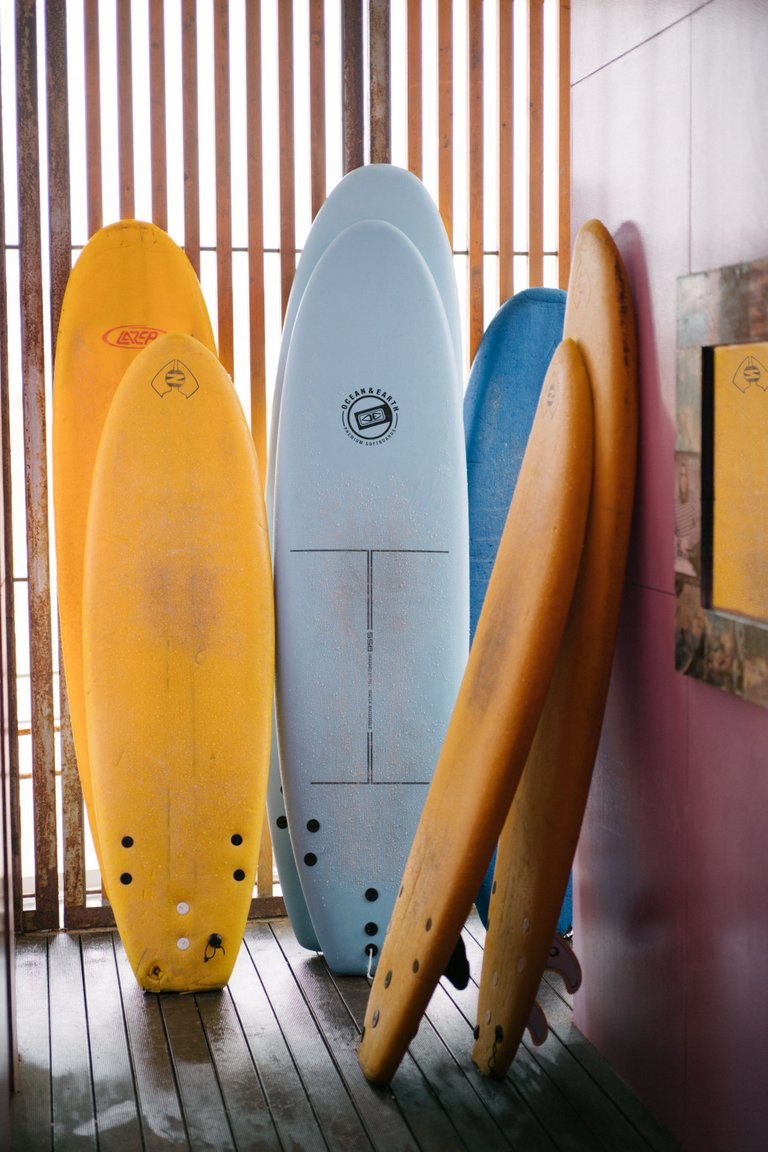English [🇺🇸]
Let's start from the beginning!
I'm not going to leave anything out and explain everything, both for you who don't know anything about surf wax and those who already know and want to learn a little more.
First, what is paraffin?
Basic concept: paraffin (the main ingredient in most surf waxes) is a product derived from petroleum that has thermoplastic properties - that is, it softens under the action of heat or hardens under the act of cold - and that is repellent to water (which does not mixture or is impermeable). There are also ecological paraffins made from vegetable wax or beeswax. I'll talk about that later!
Why and how is paraffin wax used in surfing?
Wax is used on the top of the board, where we position our feet, to give our feet grip and stability when we drop (when standing up on the board) and not slip. It must be passed over the entire surfboard area where you will step on it and applied every time you go into the sea.

Photo by Alexandre Saraiva Carniato - from Pexels
On small boards and even on funboards, wax can be used together or not with the deck, that non-slip rubber adhesive that is glued to the parts where the feet are positioned (commonly on the tail of the board). You don't need to wax the whole surfboard or the edges! Applying wax on the edges can cause more friction with the water and get in the way when maneuvering, so it is not recommended. In addition, it can give you rashes on your legs. It is only indicated to apply wax on the edge of small surfboards, on the sides where you rest your hand when you have to duck dive, preventing your hand from escaping.

Photo by Maria Fernanda Perez - from Pexels
For those who surf a longboard and like to practice that classic surf in which you want to walk to the tip of the board, you can wax the entire board.

Photo by Jess Loiterton - from Pexels
Are there different types of surf wax? Which are they?
Now getting the hang of it, as I said, paraffin is a thermoplastic material. Thus, there are paraffin waxes with specific compositions for each water temperature. That's why choosing the right surf wax for use in the water you're going to surf is essential so that it doesn't lose its function, that is so that it doesn't lose grip.
For example, if you use wax for hot water in cold water, it will harden and lose its function. And on the contrary, using wax for cold water in a place with hot water will make it melt very quickly. Based on this, there are usually the following types of paraffin:
- hot water: for when the water temperature is higher than 24ºC;
- warm water: for when the water temperature is between 19 to 23ºC;
- cold water: for when the water temperature is between 10 to 15ºC;
- chilled water: for when the water temperature is below 14ºC;
See? There's no secret. In short, a softer paraffin that melts easily is more suitable for cold waters, and harder and more heat-resistant paraffins are ideal for warmer waters.
Consequences of using the wrong wax
For example, if you use firm wax in an icy sea, your wax will harden even more, and the board will be extremely slippery. Otherwise, using soft wax in hot water will melt and become sticky, forming pellets and coming off the board easily. It can also stick to your body hair, bikini, swimsuit, lycra, or neoprene!
- Tip: when you go to buy, this information will be written on the wax packaging, so everything is clear.
But if you only have the wax, without the packaging or anything, how can you identify whether it's for cold or hot water? Simple, because of its softness. Squeeze with your fingers: if it is very soft, it is for colder water, and if it is harder, it is for hot water.
And to be very clear, the choice of wax does not depend on the ambient temperature but on the temperature of the water. The day can be hot, but if the water is freezing, use wax for colder water!
How to apply wax on the board?
Now imagine that you have a new board without wax and need to wax it before going to surf. First, ensure your board's surface is clean and dry (use a cloth to clean it).
Surf wax is sold as a tablet about the size and shape of soap. To wax the surfboard, you must press the tablet on the board so that it sticks to the surface of your board.
- Tip: break the tablet in half, especially if the wax tablet is round. It will help with the application. Use the straight part of the wax to apply.

Applying wax on a softboard | Photo by Ana Catarina
The best way to apply it is to start by making parallel lines horizontally from one edge to another and then parallel lines vertically/perpendicularly, almost like chess. Then, with one end of the tablet, apply the paraffin diagonally in both directions. And to complete, make circular movements across the area, leaving the surface of the place you will step on well covered. Great! Your board can now go into the water, and you don't have o be afraid of slipping.
- One more tip: many surfers use a "base" layer of wax, or base coat (a harder one) before applying the wax you will use. Apply a light layer to make the board opaque. This base will ensure that the wax you choose for the type of water you will surf will adhere better to the board.
How to remove the wax from the board?
Depending on the quality of the wax and the time it has been on the board, it may be necessary to change it. The main sign that it is old is when it turns yellowish or loses grip and becomes smooth and/or hard. You only need a cotton cloth, a scraper, and a little heat to remove the wax from the board.

Dewaxing a board with a wax scraper. Photo by Ana Catarina
The most natural and easiest way to remove wax from your board is by placing the board in the sun so that the wax softens with the heat. Just be careful not to leave too much time in the sun, as excessive heat can damage the board. Leave just enough time for the wax to soften and be able to be removed more easily. Usually, 5 minutes is enough. If there is no sun or it is not hot, another option is to use a hair dryer or a specific paraffin remover. Don't try to use alcohol, vinegar, thinner, oil, or any chemical that you "think will work," as it could damage your board, okay?
Now what you need is a scraper! Use the back of the scraper, which is straight and slightly beveled, to scrape and remove the paraffin from the board. No rush and no force. Removing all the wax from the board is unnecessary, but the more you can remove it, the better. Finally, to leave the board smooth again, finish by passing a cotton cloth to remove the excess. And voila! Your board is ready to receive a new wax!
Some important tips
As wax is very sensitive to heat, you must store it in a cool and airy place so that it does not melt, maintains its quality, and lasts longer. Likewise, keep your board (with or without wax) stored in the coolest place in your house and away from the sun, preferably inside a cover.

Photo by Arthouse Studio - from Pexels
And the precious tip that many people ignore: on that sunny day at the beach, before or after surfing, leave the board in the shade or under an umbrella, with the top of it facing the sand. All this to prevent the wax from melting!

Photo by Raphael Amaral - from Pexels
And another thing... It's always good to "renew" the wax when surfing. With each surf, some of the wax on your board "leaves" naturally, mainly because of our body's constant contact with the board. So always have a wax tablet with you. And always have a scraper, too: a cool tip is, if you don't have wax, use the "toothed" part of the scraper and pass it over the wax on the board to spread it out. This will also give your feet more grip.
Last but not least: eco-friendly alternatives
As I said at the beginning, most of the waxes used in surfing are derived from petroleum and may contain substances that can harm the environment. Many people may be polluting the sea without knowing it! There are already lots of ecological wax options on the market.
They are made from vegetable wax or beeswax, being naturally biodegradable, less harmful to the environment, and do not cause damage to the atmosphere and aquatic organisms. And the types are the same as the traditional ones for each temperature. And be very careful when removing the wax of your board if you are at the beach, especially if the wax is derived from petroleum. Be careful not to drop it in the sand. Collect and throw in the trash!
Tip: do not mix ecological waxes with conventional ones on the same board. As the wax base is different, they will not combine and will not give the desired effect for surfing: adherence. So, for example, if you use conventional wax on your board and want to switch to ecological wax (or vice versa), remove all the old wax before using the new one.
Another very interesting option is to use non-slip adhesives that replace wax. They are lightweight, thin, transparent (they won't cover your board's paint), and non-absorbent (i.e., they won't soak). Just stick the stickers on the board, and you completely dispense with the use of wax. More perks? It can be used at any temperature, does not melt, does not release residues, and does not contaminate water. And the durability is so great that the chance of you having to change the stickers is minimal, in addition to offsetting the cost-effectiveness for your pocket and the environment.
So if you can, make the most conscious choice, always. Give preference to biodegradable ecological waxes.
Surf wax is a profitable subject, right? All care is little and necessary. Take good care of your wax, your board, and the environment.
Mahalo!!
About me
Biologist, Photographer, Content Producer, and Community Builder. Please take a look at my introduction post to get to know me better.
My social networks:
- Personal Instagram – me, my husband, my cats, sustainability, biology curiosities, and adventures: @crisciacm
- Professional Instagram – surf, nature, and people photos: @crisciacesconettophoto
- Youtube Channel - surf videos: @crisciacesconetto
- My profile at Thatsgnar.ly - crisciacesconetto
- Twitter – Não sei o que fazer por lá, mas existe: @crisciacm
Português - BR [🇧🇷]
Vamos começar do começo!
Não vou deixar nada de fora e explicar tudinho, tanto pra você que não sabe nada de parafinas, mas também pra você que já sabe e quer aprender um pouco mais.
Primeiramente, o que é a parafina?
Conceito básico: a parafina ("wax", em inglês) é um produto derivado do petróleo que tem propriedades termoplásticas -ou seja, que amolece sob ação do calor ou endurece sob ação do frio- e que é repelente à água (que não se mistura ou é impermeável). Também já existem parafinas ecológicas, feitas a partir de cera vegetal ou cera de abelha, vou falar sobre isso depois!
Para que e como a parafina é usada no surf?
A parafina é usada na parte de cima da prancha, onde posicionamos os pés, para dar aderência e estabilidade nos nossos pés na hora do drop (na hora de subir na prancha) e não escorregar. É importante que ela seja passada em toda a área da prancha em que você for pisar e deve ser aplicada toda vez que você for entrar no mar.

Foto de Alexandre Saraiva Carniato no Pexels
Nas pranchas pequenas e até em funboards, a parafina pode ser usada em conjunto ou não com o deck, aquele adesivo de borracha antiderrapante que é colado nas partes onde os pés ficam posicionados (comumente na rabeta da prancha). Não precisa passar parafina na prancha toda, nem nas bordas! Passar parafina nas bordas pode gerar mais atrito com a água e atrapalhar na hora de fazer manobras, então não é recomendável. Além disso, ela pode deixar sua perna assada. Só é indicado passar parafina na borda de pranchinhas, nas laterais onde apoia a mão para dar o joelhinho, evitando que sua mão escape quando tiver que furar uma onda mais forte.

Foto de Maria Fernanda Perez no Pexels
No caso de quem surf de longboard (os pranchões) e gosta de praticar aquele surf clássico em que você queira andar até o bico da prancha, aí sim! Pode passar parafina na prancha toda.

Foto de Jess Loiterton no Pexels
Tem tipos de parafina diferentes? Quais são?
Já pegando o gancho, como eu falei, a parafina é um material termoplástico. Dessa forma, existem parafinas com composições específicas para cada temperatura da água. Por isso a escolha da parafina certa para o uso na água que você vai surfar é fundamental para que ela não perca a sua função, ou seja, para que ela não perca a aderência.
Por exemplo, se você usar uma parafina para água quente na água gelada, vai fazer com que ela endureça e perca a sua função. E do contrário, usar uma parafina para água gelada num local com água quente, vai fazer com que ela derreta muito rápido. Baseado nisso, existem os seguintes tipos de parafina:
- de água quente: para quando a temperatura da água for maior 24ºC;
- de água morna: para quando a temperatura da água estiver entre 19 a 23ºC;
- de água fria: para quando a temperatura da água estiver entre 10 a 15ºC;
- de água gelada: para quando a temperatura da água estiver abaixo dos 14ºC;
Viu? Não tem segredo. Resumindo, uma parafina mais mole e que derreta com facilidade é mais indicada para águas frias e as parafinas mais duras e mais resistentes ao calor são mais indicadas para águas mais quentes.
Consequências da utilização da parafina errada:
Se você utilizar uma parafina firme em um mar gelado, por exemplo, sua parafina vai endurecer ainda mais e a prancha vai ficar extremamente escorregadia. Do contrário, se utilizar uma parafina macia numa água quente ela vai derreter e ficar grudenta, formando pelotas e saindo da prancha com facilidade. Sem contar que pode grudar nos pelos do corpo e no seu biquini, lycra ou neoprene!
- Dica: na hora que você for comprar, essa informação vai estar escrita na embalagem da parafina, então não tem erro. Mas caso você tenha só a parafina, sem a embalagem nem nada, como você consegue identificar se é pra água gelada ou pra água quente? Simples, pela maciez dela. Aperte com os dedos: se ela for bem macia, é pra água mais fria, e se ela for mais dura, é pra água quente.
E vou ressaltar, pra ficar bem claro: a escolha da parafina não depende da temperatura ambiente, e sim da temperatura da água. O dia pode estar quente, mas se a água estiver gelada, use a parafina para água mais fria!
Como passar parafina na prancha?
Agora imagina que você tem uma prancha nova ou sem parafina e você precisa passar parafina nela antes de ir pro surf. Primeiro de tudo, tenha certeza que a superfície da sua prancha esteja limpa e seca (passa aquele paninho!).
A parafina para o surf é vendida em forma de um tablete mais ou menos do tamanho e no formato de um sabonete. Para passar a parafina na prancha você deve pressionar o tablete sobre a prancha de forma que ela vá "agarrando" na superfície da sua prancha.
- Dica: quebrar o tablete no meio, principalmente se ele for redondo, vai ajudar na aplicação. Use a parte reta da parafina para fazer a aplicação.

Apicano parafina na numa softboard | Foto de Ana Catarina
A melhor forma de aplicar é começar fazendo linhas paralelas no sentido horizontal de uma borda até a outra e depois linhas paralelas no sentido vertical/perpendicular, quase como se fosse um xadrex. Depois com uma das pontas do tablete passe a parafina na diagonal em ambos os sentidos. E pra completar, faça movimentos circulares em toda a área, deixando a superfície da área que você vai pisar bem coberta. Pronto! Sua prancha já pode ir pra água e você pode ficar sem medo de escorregar.
- Mais uma dica: muitos surfistas usam uma camada de parafina "base" (uma mais dura) antes de aplicar a parafina que você vai usar de fato. Passe uma camada de leve, só pra deixar a prancha opaca. Essa base vai garantir que a parafina que você vai escolher para o tipo de água que você vai surfar, vai aderir melhor na prancha.
Como tirar a parafina da prancha?
Dependendo da qualidade da parafina e do tempo que ela já está na prancha, é preciso trocá-la. O principal sinal de que ela está velha é quando ela fica amarelada, ou quando ela perde a aderência e fica lisa e/ou dura. Para tirar a parafina da prancha você só precisa de um paninho de algodão, um raspador e um pouco de calor.

Tirando a parafina da prancha com raspador. Foto de Ana Catarina
A forma mais natural e fácil de retirar a parafina da prancha é colocando a prancha no sol para que a parafina amoleça com o calor. Só cuidado pra não deixar tempo demais no sol, pois calor em excesso pode causar danos na prancha. Deixe apenas o tempo necessário para a parafina amolecer e conseguir retirar mais facilmente. Geralmente uns 5 minutinhos já são suficientes. Se não tem sol ou não está fazendo calor, um outro opção é usar um secador de cabelo ou um removedor de parafina, específico para isso. Não tente usar álcool, vinagre, solvente, óleo, ou qualquer produto químico que você "acha que vai funcionar", pois pode danificar sua prancha, tá?
Agora o que você precisa é de um raspador! Use a parte de trás do raspador, que é reta e levemente chanfrada para ir raspando e retirando a parafina da prancha. Sem pressa e sem forçar. Não é necessário retirar toda a parafina da prancha, mas quanto mais você conseguir retirar, melhor. Para finalizar, se quiser deixar a prancha lisinha novamente, finalize passando um paninho de algodão para retirar o excesso. E voilà! Sua prancha tá prontinha pra receber uma parafina nova!
Aquelas dicas importantes
Como a parafina é muito sensível ao calor, é importante que você a guarde em local fresco e arejado, para que ela não derreta, mantenha sua qualidade e dure mais tempo. Da mesma forma, nós indicamos que você também mantenha a sua prancha (com ou sem parafina) guardada no local mais fresco da sua casa e longe do sol, de preferência dentro de uma capa.

Foto de Arthouse Studio no Pexels
E a dica preciosa, mas que muita gente não presta atenção: naquele dia de sol na praia, antes ou depois do surf, deixe a prancha na sombra ou embaixo de um guarda-sol, e com a parte de cima dela virada para a areia. Tudo isso pra evitar que a parafina derreta!

Foto de Raphael Amaral no Pexels
E outra coisa... É sempre bom dar uma "renovada" na parafina sempre que você for surfar. A cada surf, um pouco da parafina na sua prancha "vai embora" naturalmente, principalmente por causa do contato constante do nosso corpo com a prancha. Então tenha sempre um tablete de parafina com você. E sempre tenha um raspador também: uma dica legal é, caso você não tenha parafina, use a parte do raspador que tem os "dentinhos" e passe sobre a parafina da prancha pra dar uma espalhada nela. Isso também vai dar mais aderência para os seus pés.
Por último, mas não menos importante: alternativas ecológicas
Como eu disse lá no início, a maioria das parafinas utilizadas no surf são derivadas do petróleo e podem conter substâncias que podem agredir o meio ambiente. Muita gente pode estar poluindo o mar sem saber! Já existem algumas opções de parafinas ecológicas no mercado.
Elas são feitas a partir de cera vegetal ou cera de abelha, sendo naturalmente biodegradáveis, que agridem menos o meio ambiente e não causam danos à atmosfera e aos organismos aquáticos. E os tipos são os mesmos das tradicionais para cada temperatura. E muito cuidado quando for remover a parafinada prancha na praia, principalmente se a parafina for derivada de petróleo. Tenha cuidado para não deixar cair na areia. Recolha e jogue no lixo!
- Dica: não misture parafinas ecológicas com as convencionais na mesma prancha. Como a base das parafinas é diferente, elas não vão se combinar e não darão o efeito desejado para o surf, que é a aderência. Então, por exemplo, se você estiver utilizando uma parafina convencional na sua prancha e quer passar a usar a ecológica (ou vice-versa), remova toda a parafina antiga antes de usar a nova.
Uma outra opção bem interessante é usar adesivos antiderrapantes que substituem a parafina. São adesivos leves, finos, transparentes (não vai cobrir a pintura da sua prancha) e não-absorventes (ou seja, não encharca). É só colar os adesivos na prancha e você dispensa totalmente o uso de parafina. Mais vantagens? Pode usar em qualquer temperatura, não derrete, não libera resíduos e não contamina a água. E a durabilidade é tão grande que a chance de você ter que trocar os adesivos é bem pequena, além de compensar o custo-benefício para o seu bolso e para o meio ambiente.
Então se puder, faça a escolha mais consciente, sempre. Dê preferência para parafinas ecológicas biodegradáveis.
Viu que parafina é um assunto que rende, né? Todo cuidado é pouco e necessário. Cuide bem da sua parafina, da sua prancha e do meio ambiente.
Mahalo!!
Sobre mim
Bióloga, Fotógrafa, Produtora de Conteúdo e Construtora de Comunidades. Dá uma olhada no meu post de introdução pra me conhecer melhor.
Minhas redes sociais:
- Instagram pessoal – eu, meu marido, meus gatos, sustentabilidade, curiosidades biológicas e aventuras: @crisciacm
- Instagram profissional – fotos de surf, natureza, e pessoas: @crisciacesconettophoto
- Canal no Youtube - videos de surf: @crisciacesconetto
- Meu perfil no Thatsgnar.ly - crisciacesconetto
- Twitter – I don't know what to do there, but it exists: @crisciacm
🙌🙌🙌
Congratulations!
Your post has been manually curated and reblogged.
You can follow our curation trail on Hive.Vote
If you want to support us and the authors we vote for you can upvote this comment or delegate some Hive Power to our account. Thanks!
Propose a worthy post by mentioning us in the post or in a comment.
We reblog curated posts, follow us if you wish to see them in your feed.
Your post was manually curated by @michupa.
Delegate your HP to the hive-br.voter account and earn Hive daily!
🔹 Follow our Curation Trail and don't miss voting! 🔹
Obrigado por ajudar a crescer a nossa comunidade Portuguesa no HIVE
iuuuu! top Criscia! 🌊
Valeu João!!
Congratulations @crisciacm! You have completed the following achievement on the Hive blockchain And have been rewarded with New badge(s)
Your next target is to reach 1500 upvotes.
You can view your badges on your board and compare yourself to others in the Ranking
If you no longer want to receive notifications, reply to this comment with the word
STOPCheck out our last posts:
Não sabia da opção de adesivo antiderrapante! Muito legal. Na dança se usa parafina quando vai ter alguma apresentação em um chão muito escorregadio, mas não temos tantas técnicas ou diferenças de parafina. E em condições normais também acaba não sendo aconselhável o uso então usamos apenas quando ta escorregando muito mesmo.
Parabéns pelo post!
Nossa! Não imaginava 🤯
Eu fiz dança de salão por muito tempo, e o chão escorregadio era muito bom. “Bom” de certa forma né? Haja core pra conseguir parar alguns movimentos num chão escorregadio 😂.
Pra que tipo de dança vocês usam parafina? Fiquei curiosa agora!!
Obrigada! ❤️
Normalmente em apresentações de chão muito escorregadio porque dança de alta performance tem movimentos aéreos onde escorregar pode causar um acidente grave. Claro que com pisos específicos pra dança isso não acontece, mas algumas apresentações que ocorrem em lugares públicos é necessário.
O primeiro evento que produzi tiveram 3 apresentações profissionais o casal campeão brasileiro daquele ano de bolero, um casal competidor de zouk e um casa campeão de um casal de samba de gafieira. O chão estava tão escorregadio que durante a coreografia de 2 dos casais teve uma queda e o casal do zouk a dama realmente se machucou e quase não conseguiu terminar a apresentação. Uma falha gigantesca minha que deveria ter oferecido parafina pra eles, mas era meu primeiro e eu não tinha experiencia com apresentações na época eu mesmo mandei encerarem o chão antes do baile.
Nesse caso era dança de salão, mas já vi danças urbanas usar parafina tb...
e legal que você fez dança de salão quem sabe um dia não participa do nosso concurso Show Your Moves :)
Realmente, a parafina com certeza deve fazer diferença!! E pode prevenir acidentes, bem importante tbm!
Oooolha, faz muuuuito tempo que não danço! Vontade enorme de voltar, quem sabe!! 🤩